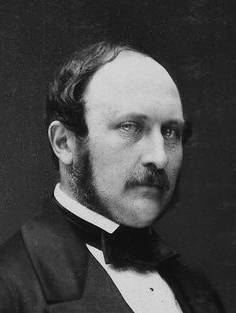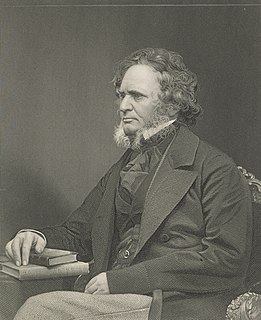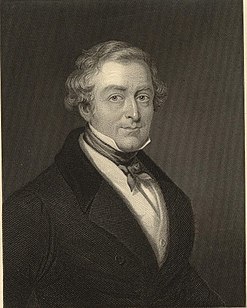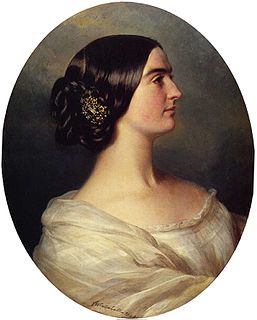
The Bedchamber Crisis occurred on 7 May 1839 after Whig politician Lord Melbourne declared his intention to resign as Prime Minister of the United Kingdom after a government bill passed by a very narrow margin of only five votes in the House of Commons. The distraught young Queen Victoria, whose ardent political sympathies were with the Whigs, first asked the Duke of Wellington, a former Tory prime minister, to form a new government, but he politely declined. She then reluctantly invited Conservative leader Robert Peel to form a government. Peel realised that such a government would hold a minority in the House of Commons and would be structurally weak, possibly damaging his future political career. [1]
The Whigs were a political faction and then a political party in the parliaments of England, Scotland, Great Britain, Ireland and the United Kingdom. Between the 1680s and 1850s, they contested power with their rivals, the Tories. The Whigs' origin lay in constitutional monarchism and opposition to absolute monarchy. The Whigs played a central role in the Glorious Revolution of 1688 and were the standing enemies of the Stuart kings and pretenders, who were Roman Catholic. The Whigs took full control of the government in 1715 and remained totally dominant until King George III, coming to the throne in 1760, allowed Tories back in. The Whig Supremacy (1715–1760) was enabled by the Hanoverian succession of George I in 1714 and the failed Jacobite rising of 1715 by Tory rebels. The Whigs thoroughly purged the Tories from all major positions in government, the army, the Church of England, the legal profession and local offices. The Party's hold on power was so strong and durable, historians call the period from roughly 1714 to 1783 the age of the Whig Oligarchy. The first great leader of the Whigs was Robert Walpole, who maintained control of the government through the period 1721–1742 and whose protégé Henry Pelham led from 1743 to 1754.

William Lamb, 2nd Viscount Melbourne, was a British Whig statesman who served as Home Secretary (1830–1834) and Prime Minister. He is best known for being prime minister in Queen Victoria's early years and her coaching in the ways of politics. Historians have concluded that Melbourne does not rank highly as a Prime Minister, for there were no great foreign wars or domestic issues to handle, he lacked major achievements, he enunciated no grand principles, and his involvement in several political scandals as Victoria's private secretary.

The Prime Minister of the United Kingdom is the head of government of the United Kingdom. The Prime Minister directs both the executive and the legislature, and together with their Cabinet are collectively accountable for their policies and actions to the Monarch, to Parliament, to their political party and ultimately to the electorate. The office of Prime Minister is one of the Great Offices of State. The current holder of the office, Theresa May, leader of the Conservative Party, was appointed by the Queen on 13 July 2016.
Peel accepted the invitation on the condition that Victoria dismiss some of her Ladies of the Bedchamber, [2] many of whom were wives or relatives of leading Whig politicians. She refused the request, considering her ladies as close friends, not as objects of political bargaining. Peel, therefore, refused to become Prime Minister and Melbourne was eventually persuaded[ by whom? ] to stay on as Prime Minister.

The Lady of the Bedchamber is the title of a lady-in-waiting holding the official position of personal attendant on a British queen or princess. The position is traditionally held by a female member of a noble family. They are ranked between the First Lady of the Bedchamber and the Women of the Bedchamber. They are also styled Gentlewoman of Her Majesty's Bedchamber.
After Victoria's marriage to Prince Albert in 1840, she relied less on her ladies as companions. In the 1841 general election, Peel's Conservatives gained a majority and Victoria appointed Peel as the new Prime Minister, a change of government for which Melbourne had meanwhile been preparing her. Accepting "the wise advice of the democratically minded Prince Albert", [3] Victoria replaced three of her Whig ladies with Conservatives.

Prince Albert of Saxe-Coburg and Gotha was the husband of Queen Victoria.
At the time of the crisis, the inexperienced Victoria was not yet twenty years old and had been on the throne less than two years. She was dismayed at the thought of losing her first, and so far only, Prime Minister, the avuncular Melbourne, who had been a wise and kindly father-figure to her in the first years of her reign—her own father, the Duke of Kent, had died when she was an infant. Victoria also mistakenly assumed that Peel wanted to replace all of her ladies—her closest friends and companions at court—when in fact Peel wished to replace only six of the twenty-five ladies, but failed to make his intentions clear to Victoria. [3]

Prince Edward, Duke of Kent and Strathearn, was the fourth son and fifth child of Britain's king, George III, and the father of Queen Victoria.
Late in life, Victoria regretted her youthful intransigence, writing to her private secretary, Arthur Bigge, 1st Baron Stamfordham: "I was very young then, and perhaps I should act differently if it was all to be done again." [3]

Lieutenant-Colonel Arthur John Bigge, 1st Baron Stamfordham, was a British Army officer and courtier. He was Private Secretary to Queen Victoria during the last few years of her reign, and to George V during most of his reign. He was the maternal grandfather of Lord Adeane, Private Secretary to Elizabeth II from 1953 to 1972.
The Bedchamber Crisis was depicted in the 2009 film The Young Victoria and in the 2016 television-drama series Victoria .

The Young Victoria is a 2009 British-American period drama film directed by Jean-Marc Vallée and written by Julian Fellowes, based on the early life and reign of Queen Victoria, and her marriage to Prince Albert of Saxe-Coburg and Gotha. Produced by Graham King, Martin Scorsese, Sarah Ferguson, and Timothy Headington, the film stars Emily Blunt, Rupert Friend, Paul Bettany, Miranda Richardson, Harriet Walter, Mark Strong, and Jim Broadbent among a large ensemble cast.

Victoria is a British television drama series created and principally written by Daisy Goodwin, which stars Jenna Coleman as Queen Victoria. The series premiered in the United Kingdom on ITV on 28 August 2016 with eight episodes, and in the United States on PBS on 15 January 2017; PBS supported its production as part of the Masterpiece anthology.













